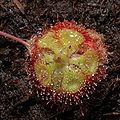| Drosera sect. Thelocalyx | |
|---|---|
 | |
| Drosera sessilifolia | |
| Scientific classification | |
| Kingdom: | Plantae |
| Clade: | Tracheophytes |
| Clade: | Angiosperms |
| Clade: | Eudicots |
| Order: | Caryophyllales |
| Family: | Droseraceae |
| Genus: | Drosera |
| Subgenus: | Drosera subg. Drosera |
| Section: | Drosera sect. Thelocalyx Planch. |
| Type species | |
| D. burmanni | |
| Species | |
| Synonyms | |
| |
Drosera sect. Thelocalyx is a section of two species in the subgenus Drosera of genus Drosera .

